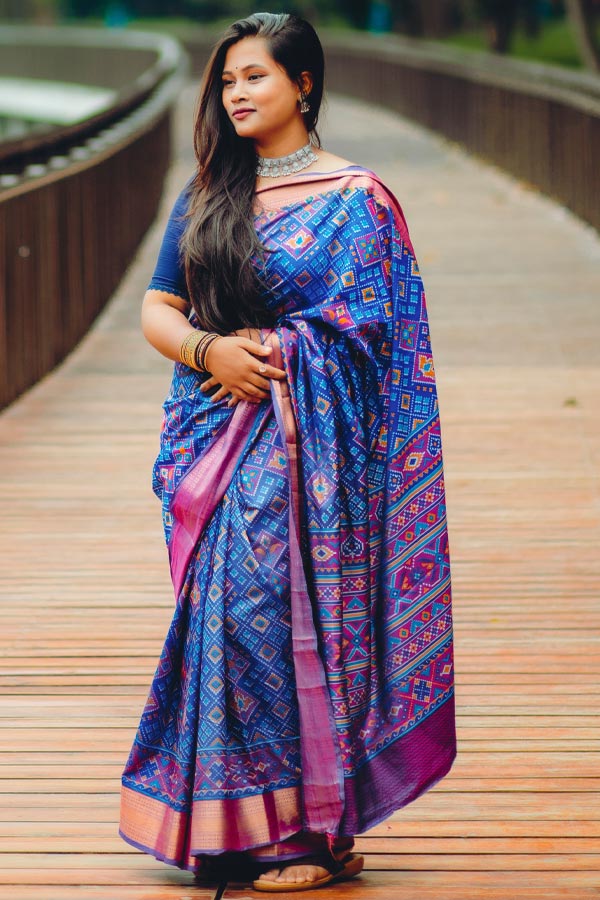What are Ashavali Sarees?
Ashavali Sarees got its name from the ancient town of Ashaval, was named after the 11th-century ruler Asha Bhil many years before Ahmed Shah found and renamed it Ahmedabad, is where many end products of brocade were woven. Reference to this unique weaving technique of Ashavali can be found back in the 16th Century. It is believed by some that the Benarasi brocade was inspired by this weaving technique when some weavers from Gujarat migrated to Benaras.
The Ashavali fabrics or also known as the Kinkhab were initially woven by the Khatris and was used only by the royalties and the nobles. They were very famous amongst the Mughal kings and were woven in 36 pano or 36-inch width; later they were woven into sarees of 45 or 48 pano or width. They were also used for jamas, patkas or used for canopies and decoration for camels and elephants. These sarees are known for their vibrant colours, high absorbency, lightweight and buoyancy.
It is said that in the late 1930s Somabhai Patel, a farmer in Ridrol village of Gujarat’s Mansa tehsil, decided to learn the technique of weaving brocade sarees with gold and silver threads on silk, thus putting the free time after sowing seeds in monsoon to good use. Many weavers from this village were engaged in the weaving of Ashavali sarees.
In the 1980s and 1990s, many weavers started to quit their profession, due to rapid industrialisation, but Somabhai Patel had developed a great liking for this art and continued. He set up two looms and employed two weavers for each loom just when the last of them was about to quit.
Now it’s been over eighty years when Somabhai Patel’s grandson Paresh Patel has continued the tradition with 22 looms and 30 weavers making Ashavali sarees.
What are the Art and the Process of making Ashavali Sarees?
The Kinkhabs were made using thick Tano or the vertical thread (warp) and thick Bano or the horizontal thread (weft).
Earlier the fabric was woven using the jala technique, which derives its name from a metallic structure on top of a loom to which the threads are attached while their corresponding ends are attached to the warp below. It required three artisans, two artisans to weave and the third one to pull the threads so that designs can be embossed on the sarees.
This technique gave way to the jacquard system, which requires only two artisans on the loom. In jacquard weaving, the designs are sketched and then punched onto paper cards; each card corresponds to a row of the design. These cards make a continuous chain and are fed into the loom and woven using a shuttle.
The only difference between the jala technique and the jacquard technique is the use of the jacquard instrument to pull threads instead of a craftsman.
A 105-cm (41.3 inches) wide jacquard pit loom is used to weave the Ahavali sarees. They are woven in twill weaving machines in sections that will have the motifs and the patterns. Twill weave is the reason why the lines on the fabric appear diagonal.
The material used to weave this saree is Mulberry silk. Initially, silk imported from China was used and was considered the best for the weaving but nowadays high-quality silk similar to the ones imported can be prepared in India itself.
The brocade motifs are so densely woven with extra weft zari/metallic yarns that the silk fabric in the background is sparsely visible.
Some of the very commonly used motifs are leaves, flowers, stems, meandering vines combined with paisleys, birds, animals, Lord Krishna and human figures. The entire composition of brocades reveals the Mughal aesthetic way of embellishing fabrics. They have a style of outlining the motifs with black or contrasting outlines resembling the inlay works or minakari. This inlay work feature is what distinguishes this Gujarat brocade from other brocades. Ashavali sarees are distinguished by the enamelled look of the border, which are sometimes woven onto Patola sarees and the interwoven designs. The pallu is also very important.
Brocade weaving is a laborious technique and a saree takes 15-20 days to complete. The prices range from Rs15,000 to Rs 2 lakh per piece. To this day, this saree is prized by Gujarati women.
What is the Current Scenario of Ashavali Sarees?
With changing times and needs of the people and society, many new approaches have been taken in producing this craft. A new colour palette, from natural dyes, has been developed for the first time to give a modern and fresh look to the saris and this sustainable approach of natural dyeing of the silk has many positive outcomes. The dyes are eco-friendly, this doesn’t have an adverse effect on the skin of the dyers as well as the wearers. Silk, being the natural fibre, absorbs the dye to its core, thereby, increasing the colour fastness and the lustre is also retained.
This new palette comprises tints and shades of reds, browns, greens to be used for the exclusive inlay work or minakari. This approach of contemporising the colour palette and retaining the traditional motifs is a successful approach towards sustaining the traditional textile, yet meeting the demands of modern-day consumers.
For so many years now, the later generations of Somabhai Patel have single-handedly kept this craft alive, with the government’s or local administration’s support. They have recently have associated with Gujarat State Handloom and Handicraft Development Association to promote the craft.

